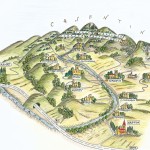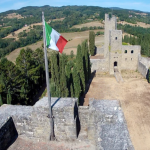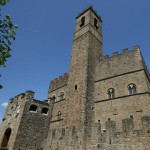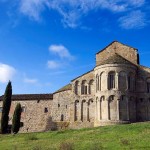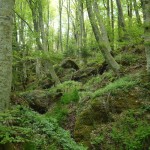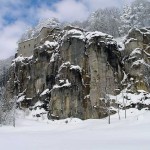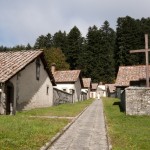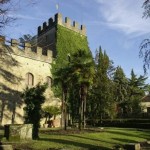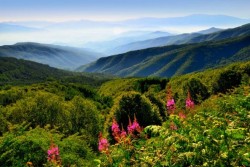 Viena iš neatrastų, tačiau 2015 metais rekomenduojamų aplankyti Italijos vietų – tai tarp Florencijos ir Arezzo nutįsęs Casentino slėnis (tarti Kazentino). Pagrindiniai regiono ir šalies turistiniai maršrutai jį aplenkia, o mes sakome – be reikalo. Casentino slėnyje, izoliuotame jį supančių kalnų, galima mėgautis ir laukine gamta, ir kultūros paveldu.
Viena iš neatrastų, tačiau 2015 metais rekomenduojamų aplankyti Italijos vietų – tai tarp Florencijos ir Arezzo nutįsęs Casentino slėnis (tarti Kazentino). Pagrindiniai regiono ir šalies turistiniai maršrutai jį aplenkia, o mes sakome – be reikalo. Casentino slėnyje, izoliuotame jį supančių kalnų, galima mėgautis ir laukine gamta, ir kultūros paveldu.
Casentino slėnis – tai vieta, kurioje Arno upės suformuotas slėnis palengva virsta neaukštomis kalvomis, o pastarosios perauga į kalnus. Rodos, kad šį slėnį aplenkė tokie civilizacijos reiškiniai kaip greitkelių statyba ar miestų plėtra. Būtent todėl čia galima pasimėgauti ramybe, čia auga tankūs miškai, vynuogynai ir alyvų sodai, šniokščia krištolo skaidrumo upeliai, ant uolingų kalvų kyla vienuolynai ir bažnyčios, saldžiame sapne snaudžia maži miesteliai ir fortifikuoti kaimai. Čia galima pajusti tikrą turizmo nesugadintą Toskaną.
La Verna pranciškonų vienuolynas. Casentino slėnis garsėja čia esančiu religiniu paveldu, ypač su Šv. Pranciškumi susijusiomis vietomis. Viena iš tokių – La Verna pranciškonų vienuolynas, iš toli matomas, ant stačios uolos šlaito, apsuptas tankių miškų. Tikima, kad jis buvo pastatytas toje vietoje, kurioje šv. Pranciškui atsivėrė stigmos. Dabar čia lankytojų laukia vienuolynas, bažnyčia ir kelios koplyčios, muziejus ir ola, kurioje, kaip tikima, buvo šventojo celė. Nuo La Verna vienuolyno komplekso atsiveria Casentino slėnio vaizdai.
Eremo di Camaldoli. Viduryje Casentino Nacionalinio parko miškų galima rasti nepaprastai dvasingą vietą – Eremo di Camaldoli, t.y. kamaldulių vienuolyną. Pats žodis eremo italų kalboje reiškią tolimą, nuošalią vietą, prieglobstį. Casentino slėnyje toks “prieglobstis” buvo įkurtas benediktinų vienuolio šv. Romualdo 1012 metais. Dabar čia stovi vienuolynas ir „prieglobstis“, galima aplankyti šventojo celę ir bažnyčią. Vietos vienuoliai čia užsiima žemės ūkiu, o produktų galima nusipirkti Villa Mausolea, esančioje Soci kaimelyje.
San Pietro a Romena bažnyčia. San Pietro a Romena bažnyčia yra tikras romaninės architektūros perlas. Bažnyčia buvo pastatyta XII amžiaus viduryje, čia jau buvusio pastato vietoje, kurio liekanos datuojamos VIII amžiumi. Verta užsukti ir pasigrožėti interjeru, ypač kapitelių papuošimais. Masyvi San Pietro a Romena bažnyčia laikoma vienais iš svarbiausių maldos namų slėnyje.
Įspūdingiausios Casentino pilys
Castello di Poppi, Castello dei Conti Guidi. Viena iš gražiausių ir geriausiai išlikusių Toskanos viduramžių pilių ir, turbūt, garsiausia Casentino slėnio lankytina vieta. Pilis stovi Poppi miestelio viduryje ant neaukštos kalvos ir yra matyti iš toli (ypač gražus vaizdas atsiveria rytais važiuojant iš Florencijos Poppi link). Pilis priklausė vienai galingiausių slėnio kilmingų Conti Guidi šeimų. Galima aplankyti visą pilį. Joje yra ir viena didžiausių Italijos viduramžių knygų (25 000), rankraščių (800) ir inkunabulų (700) kolekcija, saugoma Rilliana bibliotekoje. www.castellodipoppi.it
Castello di Romena. Iš XI amžiuje pirmą kartą paminėtos Romenos pilies dabar likę tik griuvėsiai, tačiau apsilankyti šioje vietoje verta. Romenos pilyje kurį laiką gyveno Dantė po to, kai buvo ištremtas iš Florencijos. 1440 m. pilis buvo sugriauta Milano kariuomenės, vėliau atstatyta, galiausiai bombarduota II Pasaulinio karo metais.
Castello di Porciano. Šią pilį lengva pastebėti atvykus į Stia miestelį. Nuo XI amžiaus ši pilis taip pat priklausė Conti Guidi šeimai. Porciano pilis yra vienintelė iš trijų, kurioje ne tik įrengtas muziejus, bet ir gyvena dabartinis jos šeimininkas.
Casentino Miškų Nacionalinis Parkas. Casentino Miškų Nacionalinis Parkas yra didžiausias nacionalinis parkas Italijoje. Jis plyti 36 000 hektarų teritorije tarp Toskanos ir Emilijos Romanijos regionų. Tankūs miškai, kalnai, ežerėliai ir upeliai vilioja gamtos mylėtojus. Parko direkcija siūlo daugybę pramogų, tokių kaip pažintinės ekskursijos su gidu, naktinio dangaus stebėjimas planetariume, žygiai pėsčiomis, kalnų dviračiai, jodinėjimas, o žiemą čia netgi galima slidinėti. www.parcoforestecasentinesi.it
Pagrindiniai Casentino miesteliai
Poppi. Viduramžius menantis Poppi miestelis yra laikomas vienu iš geriausiai išlikusių siena apjuostų gyvenviečių Toskanos regione. Svarbiausias lankytinas objektas – Poppi pilis.
Bibbiena. Seniausia Bibbienos dalis – ant nedidelės kalvos esantis fortifikuotas viduramžiais atsiradęs miestelio centras. Įdomiausi čia – XVI amžiaus Palazzo Dovizi rūmai.
Stia. Stia istorija siekia romėnų laikus. Miestelyje verta užsukti į Santa Maria delle Grazie bažnyčią ir įspūdingus Palagio Fiorentino rūmus.
Pratovecchio. Pratovecchio buvo vienas iš svarbiausių Conti Guidi šeimos imperijos, dominavusios iki XV amžiaus, židinių. Pasivaikščiokite po miestelį!
Montemignaio. Žavingas Montemignaio kaimelis pūpso ant aukštos kalvos viršūnės. Pačioje aukščiausioje kaimo vietoje stovi galinga Leone pilis, pastatyta XII amžiuje. Tuo tarpu XII amžiaus romaninio stiliaus Santa Maria Assunta bažnyčia laikoma vienu svarbiausių sakralinės architektūros pavyzdžių slėnyje. Joje saugomi keli vertingi meno kūriniai, tarp kurių paveikslas „Madonna con Bambino“, priskiriamas Michele di Ridolfo del Ghirlandaio.
© unseentuscany.com, www.turismo.intoscana.it


